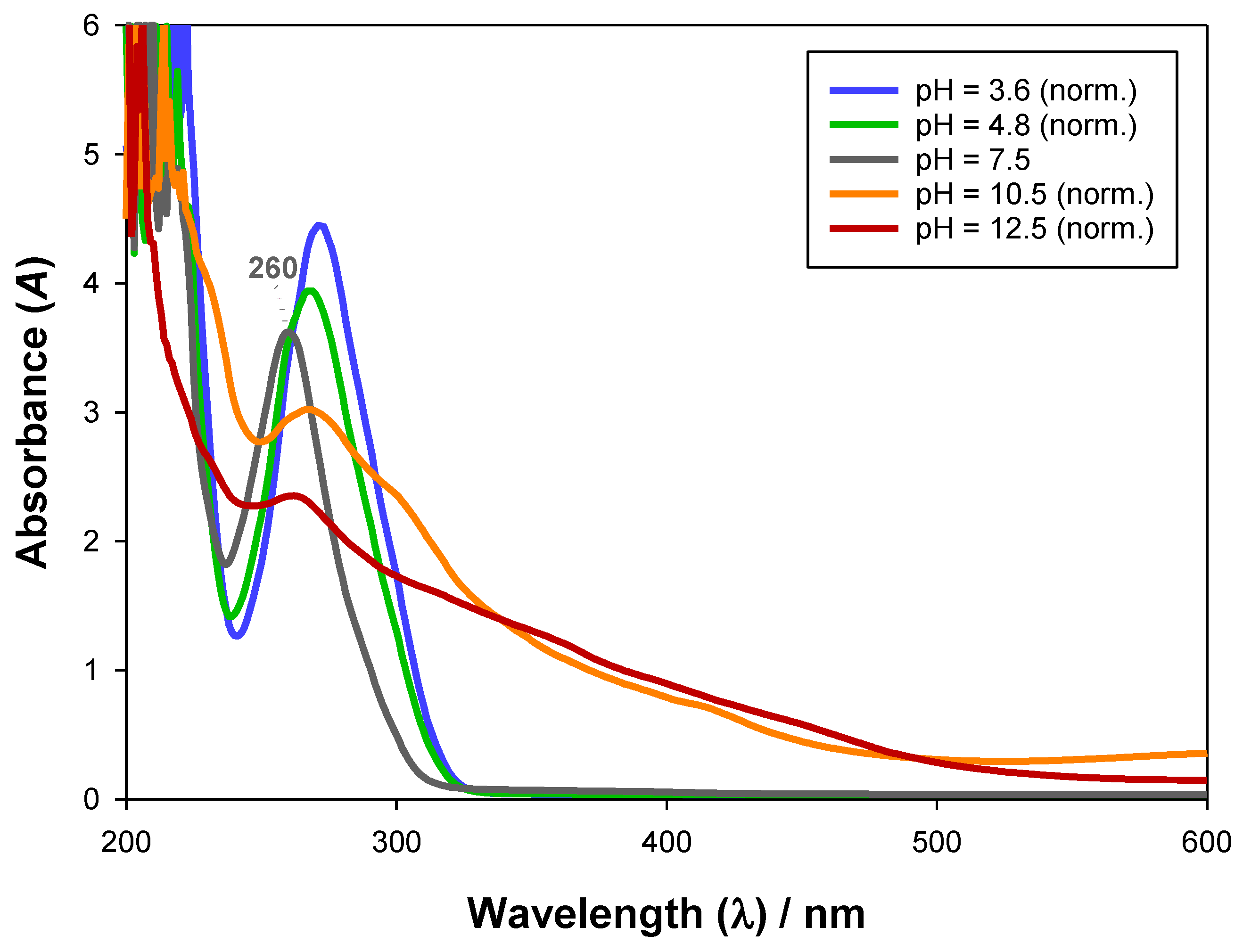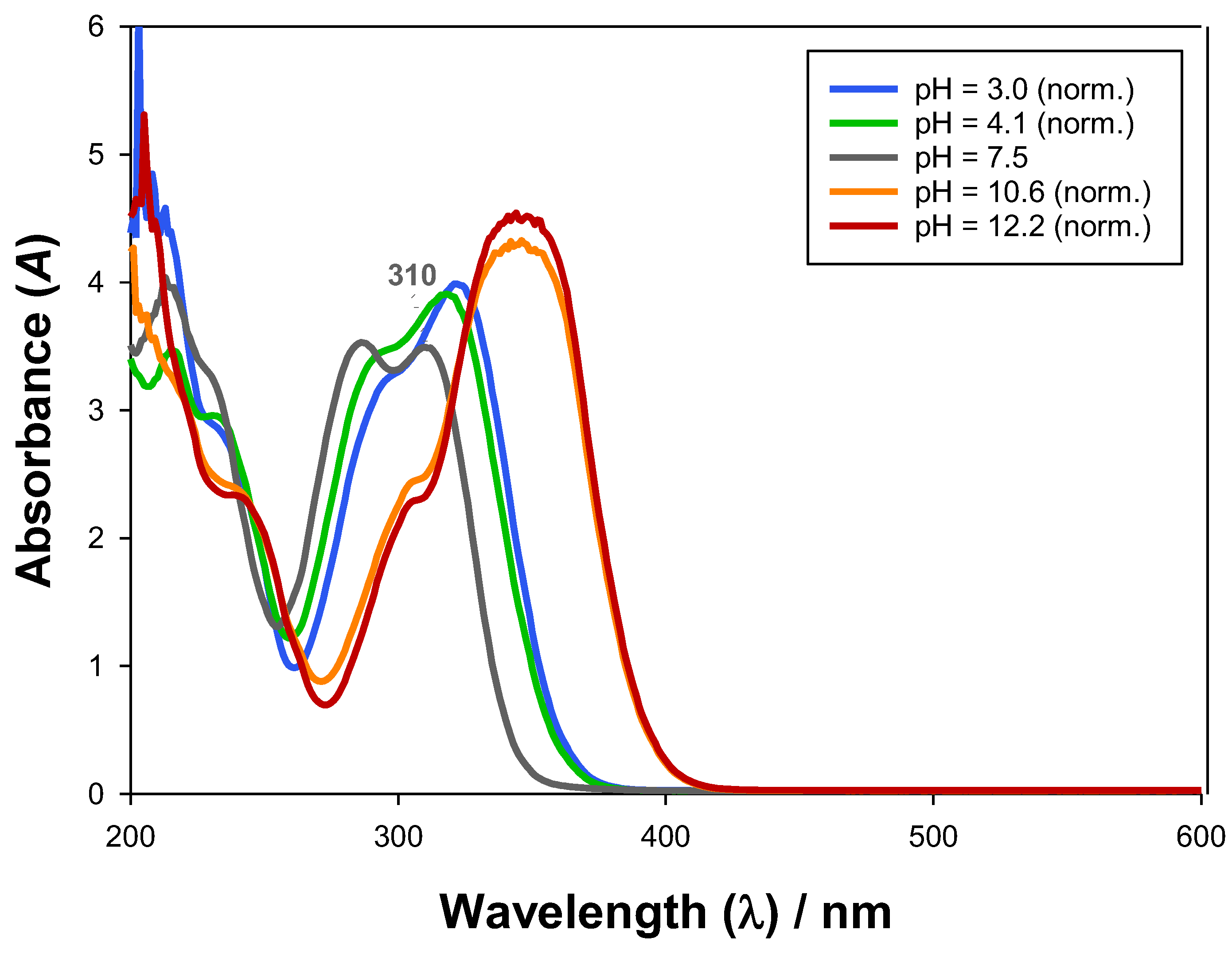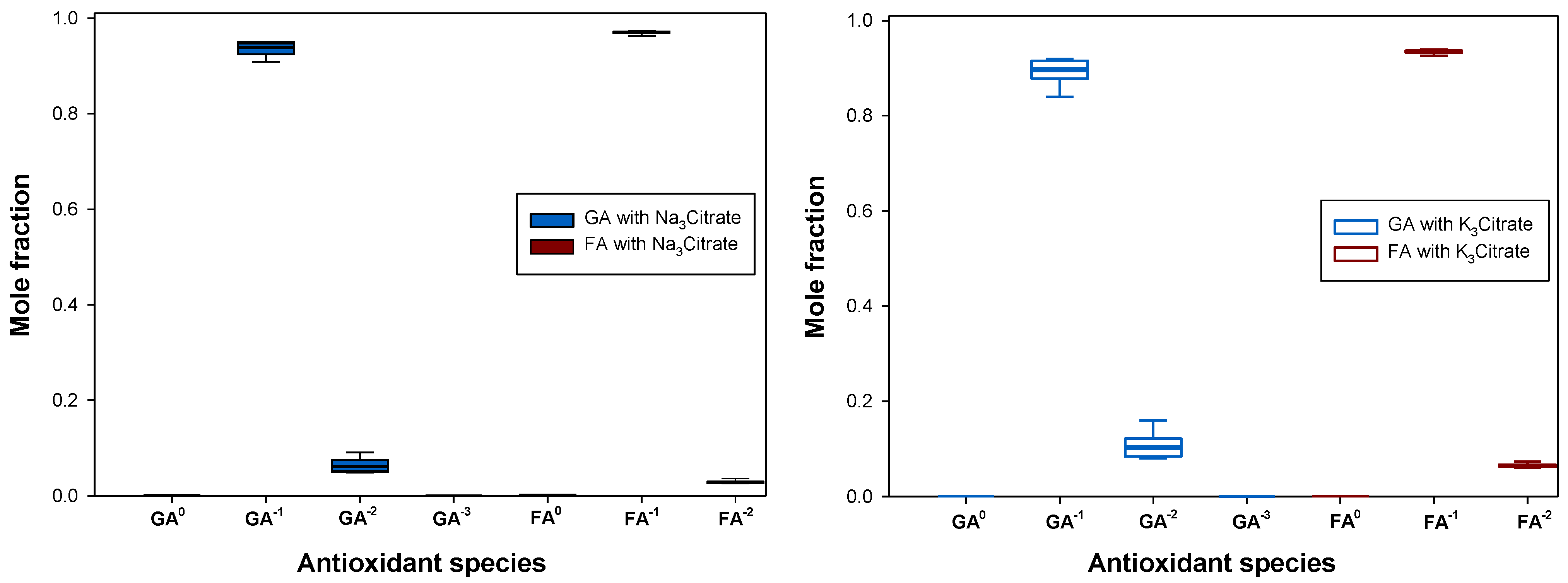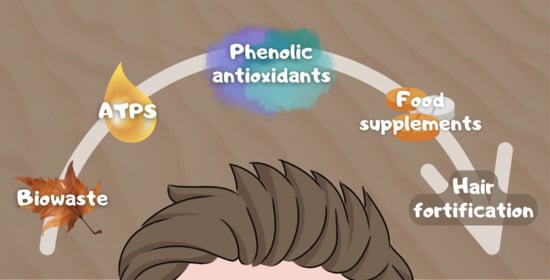Extraction of Gallic Acid and Ferulic Acid for Application in Hair Supplements
Abstract
1. Introduction
2. Materials and Methods
2.1. Chemicals
2.2. Apparatus and Experimental Procedure
2.2.1. Effect of pH in the UV-Vis Absorbance Spectra
2.2.2. UV-Vis Absorbance Calibration Curves
2.2.3. Liquid-Liquid Equilibria
2.2.4. Extraction of Biomolecules
3. Results and Discussion
3.1. Effect of pH in the Mean Electrical Charge
3.2. Effect of pH in the Absorbance Spectra
3.3. Partition Coefficients and Extraction Efficiencies
3.4. Effect of Tie-Line Composition in the Antioxidant Stages Distribution
4. Conclusions
Supplementary Materials
Author Contributions
Funding
Institutional Review Board Statement
Informed Consent Statement
Data Availability Statement
Acknowledgments
Conflicts of Interest
Sample Availability
References
- Cotsarelis, G.; Millar, S.E. Towards a molecular understanding of hair loss and its treatment. Trends Mol. Med. 2001, 7, 293–301. [Google Scholar] [CrossRef] [PubMed]
- Rushton, D.H.; Norris, M.J.; Dover, R.; Busuttil, N. Causes of hair loss and the developments in hair rejuvenation. Int. J. Cosmet. Sci. 2002, 24, 17–23. [Google Scholar] [CrossRef] [PubMed]
- Sadick, N.S. New-Generation Therapies for the Treatment of Hair Loss in Men. Dermatol. Clin. 2018, 36, 63–67. [Google Scholar] [CrossRef] [PubMed]
- Zgonc Škulj, A.; Poljšak, N.; Kočevar Glavač, N.; Kreft, S. Herbal preparations for the treatment of hair loss. Arch. Dermatol. Res. 2020, 312, 395–406. [Google Scholar] [CrossRef]
- Phillips, T.G.; Slomiany, W.P.; Allison, R. Hair Loss: Common Causes and Treatment. Am. Fam. Physician 2017, 96, 371–378. [Google Scholar]
- Lourith, N.; Kanlayavattanakul, M. Hair loss and herbs for treatment. J. Cosmet. Dermatol. 2013, 12, 210–222. [Google Scholar] [CrossRef]
- Badolati, N.; Sommella, E.; Riccio, G.; Salviati, E.; Heintz, D.; Bottone, S.; Cicco, E.D.; Dentice, M.; Tenore, G.; Campiglia, P.; et al. Annurca Apple Polyphenols Ignite Keratin Production in Hair Follicles by Inhibiting the Pentose Phosphate Pathway and Amino Acid Oxidation. Nutrients 2018, 10, 1406. [Google Scholar] [CrossRef]
- Velho, P.; Oliveira, I.; Gómez, E.; Macedo, E.A. pH Study and Partition of Riboflavin in an Ethyl Lactate-Based Aqueous Two-Phase System with Sodium Citrate. J. Chem. Eng. Data 2022, 67, 1985–1993. [Google Scholar] [CrossRef]
- Tsao, R. Chemistry and Biochemistry of Dietary Polyphenols. Nutrients 2010, 2, 1231–1246. [Google Scholar] [CrossRef]
- Losada-Barreiro, S.; Bravo-Díaz, C. Free radicals and polyphenols: The redox chemistry of neurodegenerative diseases. Eur. J. Med. Chem. 2017, 133, 379–402. [Google Scholar] [CrossRef]
- Requejo, P.F.; Velho, P.; Gómez, E.; Macedo, E.A. Study of Liquid−Liquid Equilibrium of Aqueous Two-Phase Systems Based on Ethyl Lactate and Partitioning of Rutin and Quercetin. Ind. Eng. Chem. Res. 2020, 59, 21196–21204. [Google Scholar] [CrossRef]
- Bors, W.; Michel, C. Chemistry of the antioxidant effect of polyphenols. Ann. N. Y. Acad. Sci. 2002, 957, 57–69. [Google Scholar] [CrossRef]
- Palacios, I.; Lozano, M.; Moro, C.; D’Arrigo, M.; Rostagno, M.A.; Martínez, J.A.; García-Lafuente, A.; Guillamón, E.; Villares, A. Antioxidant properties of phenolic compounds occurring in edible mushrooms. Food Chem. 2011, 128, 674–678. [Google Scholar] [CrossRef]
- Fernandes, F.H.; Salgado, H.R. Gallic Acid: Review of the Methods of Determination and Quantification. Crit. Rev. Anal. Chem. 2016, 46, 257–265. [Google Scholar] [CrossRef]
- Tsioptsias, C.; Tsivintzelis, I. Insights on thermodynamic thermal properties and infrared spectroscopic band assignments of gallic acid. J. Pharm. Biomed. Anal. 2022, 221, 115065. [Google Scholar] [CrossRef] [PubMed]
- Ow, Y.Y.; Stupans, I. Gallic acid and gallic acid derivatives: Effects on drug metabolizing enzymes. Curr. Drug. Metab. 2003, 4, 241–248. [Google Scholar] [CrossRef] [PubMed]
- Cláudio, A.F.M.; Ferreira, A.M.; Freire, C.S.R.; Silvestre, A.J.D.; Freire, M.G.; Coutinho, P.J.A. Optimization of the gallic acid extraction using ionic-liquid-based aqueous two-phase systems. Sep. Purif. Technol. 2012, 97, 142–149. [Google Scholar] [CrossRef]
- Du, F.-Y.; Xiao, X.-H.; Luo, X.-J.; Li, G.-K. Application of ionic liquids in the microwave-assisted extraction of polyphenolic compounds from medicinal plants. Talanta 2009, 78, 1177–1184. [Google Scholar] [CrossRef] [PubMed]
- Baite, T.N.; Mandal, B.; Purkait, M.K. Ultrasound assisted extraction of gallic acid from Ficus auriculata leaves using green solvent. Food Bioprod. Process. 2021, 128, 1–11. [Google Scholar] [CrossRef]
- Khodaie, F.; Ghoreishi, S.M. Experimental extraction of gallic acid from brown sumac seed (Rhus coriaria) using supercritical carbon dioxide and ethanol as co-solvent: Modeling and optimization. J. Supercrit. Fluids 2021, 175, 105266. [Google Scholar] [CrossRef]
- Badhani, B.; Sharma, N.; Kakkar, R. Gallic acid: A versatile antioxidant with promising therapeutic and industrial applications. RSC Advances 2015, 5, 27540–27557. [Google Scholar] [CrossRef]
- Tilay, A.; Bule, M.; Kishenkumar, J.; Annapure, U. Preparation of ferulic acid from agricultural wastes: Its improved extraction and purification. J. Agric. Food. Chem. 2008, 56, 7644–7648. [Google Scholar] [CrossRef] [PubMed]
- Mota, F.L.; Queimada, A.J.; Pinho, S.P.; Macedo, E.A. Aqueous Solubility of Some Natural Phenolic Compounds. Ind. Eng. Chem. Res. 2008, 47, 5182–5189. [Google Scholar] [CrossRef]
- Kumar, N.; Pruthi, V. Potential applications of ferulic acid from natural sources. Biotechnol. Rep. 2014, 4, 86–93. [Google Scholar] [CrossRef]
- Graf, E. Antioxidant potential of ferulic acid. Free Radical Biol. Med. 1992, 13, 435–448. [Google Scholar] [CrossRef] [PubMed]
- González-Amado, M.; Tavares, A.P.M.; Freire, M.G.; Soto, A.; Rodríguez, O. Recovery of lactose and proteins from cheese whey with poly(ethylene)glycol/sulfate aqueous two-phase systems. Sep. Purif. Technol. 2021, 255, 117686. [Google Scholar] [CrossRef]
- Santhi, J.V.; Tavanandi, H.A.; Sharma, R.; Prabhakar, R.; Raghavarao, K.S.M.S. Differential partitioning of coconut whey proteins and fat using aqueous two phase extraction. Fluid Phase Equilib. 2020, 503, 112314. [Google Scholar] [CrossRef]
- Barros, D.P.C.d.; Campos, S.R.R.; Azevedo, A.M.; Baptista, A.M.; Aires-Barros, M.R. Predicting protein partition coefficients in aqueous two phase system. J. Chromatogr. A 2016, 1470, 50–58. [Google Scholar] [CrossRef]
- Velho, P.; Requejo, P.F.; Gómez, E.; Macedo, E.A. Novel ethyl lactate based ATPS for the purification of rutin and quercetin. Sep. Purif. Technol. 2020, 252, 117447. [Google Scholar] [CrossRef]
- Veloso, A.V.; Silva, B.C.; Bomfim, S.A.; Souza, R.L.; Soares, C.M.F.; Lima, Á.S. Selective and continuous recovery of ascorbic acid and vanillin from commercial diet pudding waste using an aqueous two-phase system. Food Bioprod. Process. 2020, 119, 268–276. [Google Scholar] [CrossRef]
- Velho, P.; Marques, L.; Macedo, E.A. Extraction of Polyphenols and Vitamins Using Biodegradable ATPS Based on Ethyl Lactate. Molecules 2022, 27, 7838. [Google Scholar] [CrossRef] [PubMed]
- Lima, T.S.P.; Borges, M.M.; Buarque, F.S.; Souza, R.L.d.; Soares, C.M.F.; Lima, Á.S. Purification of vitamins from tomatoes (Solanum lycopersicum) using ethanolic two-phases systems based on ionic liquids and polypropylene glycol. Fluid Phase Equilib. 2022, 557, 113434. [Google Scholar] [CrossRef]
- Lu, X.; Lu, Z.; Zhang, R.; Zhao, L.; Xie, H. Distribution of pigments in the aqueous two-phase system formed with piperazinium-based ionic liquid and anionic surfactant. J. Mol. Liq. 2021, 330, 115677. [Google Scholar] [CrossRef]
- Zhang, H.; Wang, Y.; Zhou, Y.; Chen, J.; Wei, X.; Xu, P. Aqueous biphasic systems formed by deep eutectic solvent and new-type salts for the high-performance extraction of pigments. Talanta 2018, 181, 210–216. [Google Scholar] [CrossRef]
- Ghaffari, F.; Zafarani-Moattar, M.T.; Shekaari, H. Aqueous biphasic systems created with choline chloride -fructose natural deep eutectic solvents and polypropylene glycol 400 and usage of these systems for extraction of some commonly used drugs. Fluid Phase Equilib. 2022, 555, 113348. [Google Scholar] [CrossRef]
- Ferreira, G.M.D.; Ferreira, G.M.D.; Maldaner, A.O.; Silva, L.H.M.d.; Hespanhol, M.C. Partitioning of cocaine and its adulterants in aqueous two-phase systems: An alternative drug identification method. Fluid Phase Equilib. 2020, 506, 112367. [Google Scholar] [CrossRef]
- Yao, T.; Song, J.; Gan, Y.; Feng, C.; Peng, L. Liquid-liquid equilibria for (polypropylene glycol 400 based magnetic ionic liquids + inorganic salts) aqueous two-phase systems at 298.15 K. J. Mol. Liq. 2022, 349, 118203. [Google Scholar] [CrossRef]
- Yu, Y.-Y.; Zhang, W.; Cao, S.-W. Extraction of Ferulic Acid and Caffeic Acid with Ionic Liquids. Chin. J. Anal. Chem. 2007, 35, 1726–1730. [Google Scholar] [CrossRef]
- Kamalanathan, I.; Petrovski, Z.; Branco, L.C.; Najdanovic-Visak, V. Novel aqueous biphasic system based on ethyl lactate for sustainable separations: Phase splitting mechanism. J. Mol. Liq. 2018, 262, 37–45. [Google Scholar] [CrossRef]
- Pereira, C.; Silva, V.; Rodrigues, A. Ethyl lactate as a solvent: Properties, applications and production processes—A review. Green Chem. 2011, 13, 2658–2671. [Google Scholar] [CrossRef]
- Aparicio, S.; Alcalde, R. The green solvent ethyl lactate: An experimental and theoretical characterization. Green Chem. 2009, 11, 65–78. [Google Scholar] [CrossRef]
- Wysoczanska, K.; Do, H.T.; Held, C.; Sadowski, G.; Macedo, E.A. Effect of different organic salts on amino acids partition behaviour in PEG-salt ATPS. Fluid Phase Equilib. 2018, 456, 84–91. [Google Scholar] [CrossRef]
- Lenzi, L.J.; Lucchesi, P.M.A.; Medico, L.; Burgán, J.; Krüger, A. Effect of the Food Additives Sodium Citrate and Disodium Phosphate on Shiga Toxin-Producing Escherichia coli and Production of stx-Phages and Shiga toxin. Front. Microbiol. 2016, 7, 992. [Google Scholar] [CrossRef]
- Banipal, T.S.; Kaur, H.; Kaur, A.; Banipal, P.K. Effect of tartarate and citrate based food additives on the micellar properties of sodium dodecylsulfate for prospective use as food emulsifier. Food Chem. 2016, 190, 599–606. [Google Scholar] [CrossRef] [PubMed]
- Fink, D.W.; Stong, J.D. The electronic spectral properties of gallic acid. Spectrochim. Acta Part A 1982, 38, 1295–1298. [Google Scholar] [CrossRef]
- Borges, F.; Lima, J.L.F.C.; Pinto, I.; Reis, S.; Siquet, C. Application of a Potentiometric System with Data-Analysis Computer Programs to the Quantification of Metal-Chelating Activity of Two Natural Antioxidants: Caffeic Acid and Ferulic Acid. Helv. Chim. Acta 2003, 86, 3081–3087. [Google Scholar] [CrossRef]
- Velho, P.; Barroca, L.; Macedo, E.A. Partition of antioxidants available in biowaste using a green aqueous biphasic system. Sep. Purif. Technol. 2023, 307, 122707. [Google Scholar] [CrossRef]
- Wysoczanska, K.; Nierhauve, B.; Sadowski, G.; Macedo, E.A.; Held, C. Solubility of DNP-amino acids and their partitioning in biodegradable ATPS: Experimental and ePC-SAFT modeling. Fluid Phase Equilib. 2021, 527, 112830. [Google Scholar] [CrossRef]
- Hostnik, G.; Tošović, J.; Štumpf, S.; Petek, A.; Bren, U. The influence of pH on UV/Vis spectra of gallic and ellagic acid: A combined experimental and computational study. Spectrochim. Acta Part A 2022, 267, 120472. [Google Scholar] [CrossRef]
- Friedman, M.; Jürgens, H.S. Effect of pH on the stability of plant phenolic compounds. J. Agric. Food Chem. 2000, 48, 2101–2110. [Google Scholar] [CrossRef]
- Fu, H.; Liu, K.; Alvarez, P.J.J.; Yin, D.; Qu, X.; Zhu, D. Quantifying hydrophobicity of natural organic matter using partition coefficients in aqueous two-phase systems. Chemosphere 2019, 218, 922–929. [Google Scholar] [CrossRef] [PubMed]
- Asenjo, J.A.; Andrews, B.A. Aqueous two-phase systems for protein separation: A perspective. J. Chromatogr. A 2011, 1218, 8826–8835. [Google Scholar] [CrossRef] [PubMed]






| Chemical | Supplier | Purity/m% a,b | CAS | Abbreviation |
|---|---|---|---|---|
| Ethanol (CH3CH2OH) | Sigma-Aldrich | >99 | 64-17-5 | EtOH |
| (-)-ethyl L-lactate (C5H10O3) | Sigma-Aldrich | >98 | 97-64-3 | EL |
| Ferulic acid (C10H10O4) | Sigma-Aldrich | >99 | 537-98-4 | FA |
| Gallic acid (C7H6O5) | Fluka | >98 | 149-91-7 | GA |
| Potassium citrate monohydrate (C6H5K3O7·H2O) | Sigma-Aldrich | >99 | 6100-05-6 | K3Citrate |
| Purified water (H2O) | VWR chemicals | - | 7732-18-5 | W |
| Sodium hydroxide (NaOH) | Merck | >99 | 1310-73-2 | NaOH |
| Sodium citrate tribasic dihydrate (C6H5Na3O7·2H2O) | Sigma-Aldrich | >99 | 6132-04-3 | Na3Citrate |
| Tie-Line | Feed | TLL/m% | Phase | Separation | |||
|---|---|---|---|---|---|---|---|
| w1/m% | W2/m% | w1/m% | w2/m% | pH | |||
| {EL (1) + Na3Citrate (2) + water (3)} | |||||||
| 1 | 30.0 | 11.0 | 37.85 | Top | 51.7 | 3.0 | 7.00 |
| Bottom | 16.0 | 15.7 | 6.98 | ||||
| 2 | 32.0 | 11.4 | 48.18 | Top | 57.5 | 2.0 | 6.98 |
| Bottom | 12.3 | 18.5 | 6.96 | ||||
| 3 | 34.3 | 11.7 | 55.17 | Top | 61.5 | 1.4 | 6.98 |
| Bottom | 9.8 | 20.7 | 6.97 | ||||
| 4 | 36.5 | 12.1 | 61.17 | Top | 65.0 | 1.0 | 7.00 |
| Bottom | 7.9 | 23.0 | 7.00 | ||||
| 5 | 38.5 | 12.3 | 65.44 | Top | 67.7 | 0.7 | 6.98 |
| Bottom | 6.8 | 24.7 | 6.97 | ||||
| 6 | 40.6 | 12.6 | 69.68 | Top | 70.1 | 0.5 | 6.98 |
| Bottom | 5.5 | 26.6 | 7.00 | ||||
| {EL (1) + K3Citrate (2) + water (3)} | |||||||
| 1 | 35.5 | 12.6 | 45.91 | Top | 57.9 | 3.9 | 7.21 |
| Bottom | 15.0 | 20.3 | 7.39 | ||||
| 2 | 37.5 | 13.0 | 54.02 | Top | 61.7 | 3.4 | 7.22 |
| Bottom | 11.5 | 23.2 | 7.41 | ||||
| 3 | 39.2 | 13.5 | 62.96 | Top | 67.4 | 2.1 | 7.19 |
| Bottom | 9.1 | 25.8 | 7.37 | ||||
| 4 | 41.1 | 13.9 | 68.28 | Top | 70.4 | 1.6 | 7.23 |
| Bottom | 7.5 | 28.2 | 7.41 | ||||
| 5 | 43.0 | 14.3 | 73.92 | Top | 73.6 | 1.1 | 7.12 |
| Bottom | 6.0 | 31.0 | 7.39 | ||||
| 6 | 44.6 | 14.8 | 77.66 | Top | 75.8 | 0.9 | 7.22 |
| Bottom | 5.2 | 33.1 | 7.43 | ||||
| Biomolecule | pH = 3 | pH = 4 | pH = 5 | pH = 7.5 | pH = 11 | pH = 12 | pH = 13 |
|---|---|---|---|---|---|---|---|
| Gallic acid | - | Stable | Stable | Mostly stable | Unstable NR | - | Unstable NR |
| Ferulic acid | Stable | Stable | - | Stable | Stable | Stable | - |
| Tie-Line | Phase | m/g | Lm/% | C/g·mL−1 | ρ/g·mL−1 | pH |
|---|---|---|---|---|---|---|
| Gallic Acid in {EL (1) + Na3Citrate (2) + water (3)} | ||||||
| 1 | Top | 3.9712 | −0.52 | 8.11 · 10−5 | 1.05717 | 7.36 |
| Bottom | 6.0217 | 5.83 · 10−5 | 1.12267 | 7.33 | ||
| 2 | Top | 3.9556 | −0.25 | 8.90 · 10−5 | 1.04894 | 7.33 |
| Bottom | 6.0885 | 5.27 · 10−5 | 1.13875 | 7.33 | ||
| 3 | Top | 4.7830 | −0.69 | 8.77 · 10−5 | 1.04395 | 7.35 |
| Bottom | 5.2566 | 4.79 · 10−5 | 1.15652 | 7.36 | ||
| 4 | Top | 4.7938 | −1.12 | 9.34 · 10−5 | 1.04385 | 7.36 |
| Bottom | 5.1479 | 4.30 · 10−5 | 1.17005 | 7.56 | ||
| 5 | Top | 4.8096 | −0.66 | 9.56 · 10−5 | 1.04291 | 7.39 |
| Bottom | 5.2244 | 4.02 · 10−5 | 1.17719 | 7.62 | ||
| 6 | Top | 5.1917 | −0.49 | 9.38 · 10−5 | 1.04110 | 7.44 |
| Bottom | 4.8698 | 3.67 · 10−5 | 1.19781 | 7.62 | ||
| Ferulic acid in {EL (1) + Na3Citrate (2) + water (3)} | ||||||
| 1 | Top | 4.0326 | −0.41 | 3.82 · 10−5 | 1.06631 | 7.49 |
| Bottom | 5.9923 | 2.25 · 10−5 | 1.09589 | 7.50 | ||
| 2 | Top | 4.2842 | −0.20 | 4.56 · 10−5 | 1.06154 | 7.36 |
| Bottom | 5.7625 | 1.59 · 10−5 | 1.11329 | 7.37 | ||
| 3 | Top | 4.8229 | −0.50 | 4.74 · 10−5 | 1.05130 | 7.34 |
| Bottom | 5.2068 | 1.02 · 10−5 | 1.13350 | 7.39 | ||
| 4 | Top | 5.0262 | −0.49 | 4.92 · 10−5 | 1.04683 | 7.34 |
| Bottom | 4.9886 | 7.15 · 10−6 | 1.14866 | 7.36 | ||
| 5 | Top | 5.3019 | −0.36 | 4.84 · 10−5 | 1.04361 | 7.38 |
| Bottom | 4.6933 | 5.00 · 10−6 | 1.16247 | 7.35 | ||
| 6 | Top | 5.5474 | −0.21 | 4.75 · 10−5 | 1.04404 | 7.42 |
| Bottom | 4.5557 | 3.26 · 10−6 | 1.17527 | 7.36 | ||
| Gallic acid in {EL (1) + K3Citrate (2) + water (3)} | ||||||
| 1 | Top | 5.0341 | −0.67 | 8.29 · 10−5 | 1.06598 | 7.56 |
| Bottom | 4.9839 | 5.27 · 10−5 | 1.13952 | 7.68 | ||
| 2 | Top | 5.1521 | −0.51 | 8.58 · 10−5 | 1.06438 | 7.56 |
| Bottom | 4.8572 | 4.94 · 10−5 | 1.14674 | 7.70 | ||
| 3 | Top | 5.3737 | −0.42 | 8.58 · 10−5 | 1.05704 | 7.58 |
| Bottom | 4.6898 | 4.63 · 10−5 | 1.16473 | 7.70 | ||
| 4 | Top | 5.4942 | −0.40 | 8.54 · 10−5 | 1.05212 | 7.59 |
| Bottom | 4.5353 | 4.61 · 10−5 | 1.18149 | 7.82 | ||
| 5 | Top | 5.5606 | −0.50 | 8.65 · 10−5 | 1.04930 | 7.61 |
| Bottom | 4.4468 | 4.44 · 10−5 | 1.19981 | 7.78 | ||
| 6 | Top | 5.5914 | −0.70 | 8.61 · 10−5 | 1.04942 | 7.65 |
| Bottom | 4.3850 | 4.35 · 10−5 | 1.21668 | 7.93 | ||
| Ferulic acid in {EL (1) + K3Citrate (2) + water (3)} | ||||||
| 1 | Top | 4.8465 | −0.52 | 8.29 · 10−5 | 1.07341 | 7.75 |
| Bottom | 5.1568 | 5.27 · 10−5 | 1.13804 | 7.73 | ||
| 2 | Top | 5.0310 | −0.34 | 8.58 · 10−5 | 1.05944 | 7.75 |
| Bottom | 4.9931 | 4.94 · 10−5 | 1.16013 | 7.74 | ||
| 3 | Top | 5.2857 | −0.40 | 8.58 · 10−5 | 1.05433 | 7.73 |
| Bottom | 4.7126 | 4.63 · 10−5 | 1.17877 | 7.76 | ||
| 4 | Top | 5.3688 | −0.47 | 8.54 · 10−5 | 1.04734 | 7.75 |
| Bottom | 4.6258 | 4.61 · 10−5 | 1.19250 | 7.78 | ||
| 5 | Top | 5.5171 | −0.67 | 8.65 · 10−5 | 1.04685 | 7.75 |
| Bottom | 4.4224 | 4.44 · 10−5 | 1.21242 | 7.81 | ||
| 6 | Top | 5.7985 | −0.61 | 8.61 · 10−5 | 1.04685 | 7.75 |
| Bottom | 4.3484 | 4.35 · 10−5 | 1.21885 | 7.82 | ||
| Tie-Line | LS/% | E/% | K | TLL/m% |
|---|---|---|---|---|
| Gallic acid in {EL (1) + Na3Citrate (2) + water (3)} | ||||
| 1 | −1.47 | (48.62–50.08) 0.07 | 1.39 0.05 | 37.85 |
| 2 | −1.32 | (53.64–54.97) 0.08 | 1.69 0.06 | 48.18 |
| 3 | −1.05 | (64.16–65.21) 0.09 | 1.83 0.07 | 55.17 |
| 4 | −1.28 | (68.5–69.2) 0.1 | 2.17 0.09 | 61.17 |
| 5 | −1.06 | (70.4–71.5) 0.1 | 2.4 0.2 | 65.44 |
| 6 | −1.62 | (74.6–76.2) 0.2 | 2.6 0.2 | 69.68 |
| Ferulic acid in {EL (1) + Na3Citrate (2) + water (3)} | ||||
| 1 | −1.79 | (53.0–54.8) 0.3 | 0.08 | 37.85 |
| 2 | −2.50 | (67.4–69.9) 0.3 | 2.9 0.2 | 48.18 |
| 3 | −2.98 | (79.7–82.7) 0.4 | 4.6 0.5 | 55.17 |
| 4 | −2.09 | (86.5–88.6) 0.4 | 6.9 0.9 | 61.17 |
| 5 | −1.77 | (90.8–92.5) 0.4 | 10 2 | 65.44 |
| 6 | −2.63 | (92.7–95.4) 0.4 | 15 5 | 69.68 |
| Gallic acid in {EL (1) + K3Citrate (2) + water (3)} | ||||
| 1 | −1.15 | (62.10–63.25) 0.09 | 0.06 | 45.91 |
| 2 | −1.21 | (65.57–66.77) 0.09 | 1.73 0.07 | 54.02 |
| 3 | −1.16 | (69.1–70.3) 0.1 | 1.84 0.08 | 62.96 |
| 4 | −0.90 | (70.8–71.7) 0.1 | 1.85 0.08 | 68.28 |
| 5 | −1.15 | (72.7–73.8) 0.1 | 1.94 0.08 | 73.92 |
| 6 | −1.10 | (73.6–74.7) 0.2 | 1.97 0.09 | 77.66 |
| Ferulic acid in {EL (1) + K3Citrate (2) + water (3)} | ||||
| 1 | −1.43 | (71.4–72.8) 0.3 | 0.2 | 45.91 |
| 2 | −1.71 | (83.2–85.0) 0.4 | 5.0 0.5 | 54.02 |
| 3 | −1.38 | (90.1–91.5) 0.4 | 8 2 | 62.96 |
| 4 | −1.21 | (93.0–94.2) 0.4 | 12 3 | 68.28 |
| 5 | −1.77 | (95.0–96.7) 0.4 | 20 8 | 73.92 |
| 6 | −0.94 | (96.7–97.6) 0.4 | (3 2) · 101 | 77.66 |
Disclaimer/Publisher’s Note: The statements, opinions and data contained in all publications are solely those of the individual author(s) and contributor(s) and not of MDPI and/or the editor(s). MDPI and/or the editor(s) disclaim responsibility for any injury to people or property resulting from any ideas, methods, instructions or products referred to in the content. |
© 2023 by the authors. Licensee MDPI, Basel, Switzerland. This article is an open access article distributed under the terms and conditions of the Creative Commons Attribution (CC BY) license (https://creativecommons.org/licenses/by/4.0/).
Share and Cite
Velho, P.; Rebelo, C.S.; Macedo, E.A. Extraction of Gallic Acid and Ferulic Acid for Application in Hair Supplements. Molecules 2023, 28, 2369. https://doi.org/10.3390/molecules28052369
Velho P, Rebelo CS, Macedo EA. Extraction of Gallic Acid and Ferulic Acid for Application in Hair Supplements. Molecules. 2023; 28(5):2369. https://doi.org/10.3390/molecules28052369
Chicago/Turabian StyleVelho, Pedro, Catarina S. Rebelo, and Eugénia A. Macedo. 2023. "Extraction of Gallic Acid and Ferulic Acid for Application in Hair Supplements" Molecules 28, no. 5: 2369. https://doi.org/10.3390/molecules28052369
APA StyleVelho, P., Rebelo, C. S., & Macedo, E. A. (2023). Extraction of Gallic Acid and Ferulic Acid for Application in Hair Supplements. Molecules, 28(5), 2369. https://doi.org/10.3390/molecules28052369









